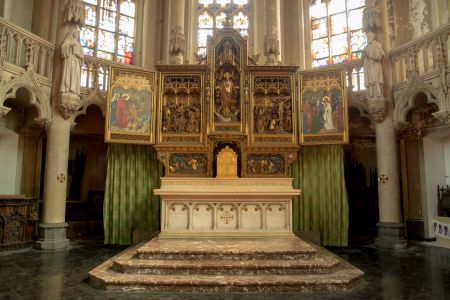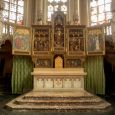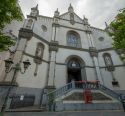Church | XIX | Neogothic | Catholic Church

Map
Opening hours
01 January - 31 December
Mon -
Tue -
Wed -
Thu 10.00 - 17.00
Fri 10.00 - 17.00
Sat 10.00 - 17.00
Sun 10.00 - 17.00
Religious offices
Sunday : 11.30 am (in French)
6 pm (in Italian)
See the updated timetable on the website of our partner Egliseinfo
Description
The building of the leading Neo-Gothic church of Brussels started in 1846 after the plans of the architect Dumont and was consecrated on 1stof April 1849. Becoming too small,it was enlarged in 1885 and consecrated in 1887 by Cardinal Goossens.
The building, including its fixed furnishings, was classified on 18/3/1999 by royal decree.
A thorough restoration of the exterior and a partial one of the interior was started in 2008 and completed in 2011.
KIKIRPA : Photo-library online
Leaflet of the church (french)
Photos
Remarkable elements
Main façade in neo-Gothic style
Of particular note is the main façade in flamboyant neo-Gothic style, which was considered at the time to be the most perfect expression of Christianity. This facade is made of Gobertange stone. It has a pyramidal structure, dominated by the spire of the bell tower, and composed of three bays, each with a portal.
Interior
However, the church has the particularity that the interior space is more marked by the neoclassical heritage, namely a relatively slender nave, while the Gothic buildings are characterized by their vertical slenderness. This more classic style is also reflected in the sobriety of the mouldings and the uniformity of the coated wall surfaces. But in 1885, when the church was enlarged, the architect Louis De Curte added a transept and built a new, wider choir, which gave the church a new plan, a Latin cross, closer to Gothic models.
Furniture
There is remarkable neo-Gothic wooden furniture, made by the workshop of the sculptor Malfait, in the second half of the 19th century. Some of this furniture is no longer in the church. But we can still admire, among other things, the confessionals and their Way of the Cross, the stalls, the organ, etc.
Wall paintings
The wall paintings of the transept and the bay preceding the choir are in fact paintings on canvas, glued to the walls. They were made by the Antwerp painter Ernst Wante.
Organ
The great romantic organ was built in 1868 by the firm "Merklin Schütze et Cie", then established on the Chaussée de Wavre. It has 31 stops spread over three keyboards and a pedalboard. The organ buffet and the rood pole balustrade are in neo-Gothic style, by the sculptor Jean-François Malfait.





























